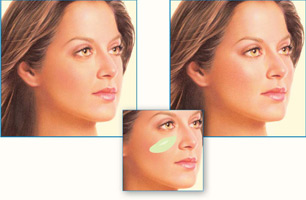Facial Implants Washington DC
Introduction
The aesthetic structure of the facial skeleton can be altered by either moving the facial bones or by adding facial implants. Dr. Baker has lectured and published extensively in both techniques and can help you differentiate the approach that best suites your goals. After a sophisticated facial analysis, Dr. Baker will discuss all of the possible approaches and assist you to develop the optimal plan to achieve your goals. Dr, Baker uses facial implants to improve and enhance facial contours. These implants can bring the face into balance by building up the chin, the cheeks, or the jaw. There are many facial implants available, manufactured from a variety of materials. They can help strengthen a jawline or bring the chin or cheekbones into balance with the rest of the face.
Dr. Baker’s Credentials for Facial Implants
- Professor and Program Director, Medstar Georgetown Department of Plastic Surgery
- Director, Center for Facial Restoration, Medstar Georgetown University hsopital
- Author multiple chapters, textbooks, and peer-reviewed manuscripts on facial skeletal and implant surgery
- Instructor national courses on skeletal facial surgery
- Invited moderator and panelist on facial surgery at national meetings
- American Society of Maxillofacial Surgeons Visiting Professor (this is a prestigious honor that selects him to visit other Plastic Surgery Departments in the United States and teach principles of facial surgery)
- Face Q pioneer and expert on outcomes studies in patient satisfaction in facial aesthetic surgery including chin, jaw, and nose surgery (one of several practices in the United States selected to participate in this study funded by the Plastic Surgery Foundation).
- Training in plastic surgery, maxillofacial surgery, and craniofacial surgery provide him the tools to perform a complete assessment of each patient’s facial structure. He is trained in all modalities of addressing your problems, so he is not limited in the solutions he can provide to address your concerns.
The Best Candidates for a Facial Implant
 If you feel that one or more of the procedures described below may benefit you, be sure to ask Dr. Baker for more information.
If you feel that one or more of the procedures described below may benefit you, be sure to ask Dr. Baker for more information.
What to Expect from a Facial Implant
Facial implants can enhance your appearance and bolster your self-esteem. If you are looking for improvement in your appearance and are realistic in your expectations, you may find that a facial implant is the right choice for you.
Dr. Baker uses such implants to bring better balance to the features of the patient. For instance, a teenage girl may want her nose reshaped and her chin brought forward so that these traits are better proportioned. The more mature patient may choose to have a cheek or chin implant placed in conjunction with another cosmetic procedure. For example, during a facelift, a patient may wish to have implants placed over the cheekbones to help restore a more youthful appearance. Implants may also be selected to fill out a face that appears “sunken” or tired.
Cheek Implant
To augment the cheek area, Dr. Baker can insert cheek implants through an incision in the mouth or through the eyelid, placing them directly on (or even below) the cheekbone. These facial implants can vary in size and shape, to achieve an individualized result.
Cheek augmentation surgery usually requires about 60 to 90 minutes. When cheek implants are being placed in conjunction with another cosmetic procedure, such as a facelift, brow lift or eyelid surgery, the implants may be inserted through the incisions made for those procedures. Otherwise, an incision will be made either inside your upper lip or your lower eyelid. Dr. Baker forms a pocket for the implant, inserts it and secures it into place so that it does not move.
Recovering from Cheek Surgery
After the surgery, a dressing may be applied to minimize discomfort and swelling. The severity and duration of such side effects may vary, especially if another cosmetic procedure was performed at the same time. Dr. Baker will provide you with instructions about post-operative care. There will be dietary restrictions as well as limitations to your activities. Again, these instructions will vary, especially if another procedure was performed along with your implant surgery. However, you should be aware that your ability to move your mouth and lips may be diminished temporarily. Stitches used to close the incisions inside your mouth usually dissolve within about 10 days.
Chin Implant (See Chin Surgery)
Chin surgery (often called mentoplasty or genioplasty), is a surgical procedure to reshape the chin. This can be accomplished by using and implant or by repositioning the chin bone (see chin surgery). In most cases the best aesthetic result is obtained by actually repositioning the chin, but in a smaller group of patients, an equally good result can be achieved with the use of an implant.
The general goal of cosmetic chin surgery is to provide a harmonious balance to your chin and facial features so that you feel better about the way you look.
Many times a plastic surgeon may recommend chin surgery to a patient having nose surgery in order to achieve facial proportion, as the size of the chin may magnify or minimize the perceived size of the nose.
With a short incision under the chin or inside your mouth, Dr. Baker can place a chin implant directly on the bone. Insertion of a chin implant may take about one hour. Before the surgery, Dr. Baker selects the proper size and shape implant to enhance your appearance. He then inserts it into a pocket over the front of the jawbone. The small incision to create the pocket and insert the implant is placed inside the mouth (along the lower lip) or in the skin just under the chin area. The implant is then secured to the bone so that it does not move.
Recovering from Chin Surgery
After chin augmentation, the chin is taped to minimize swelling and discomfort. Sutures in the skin will be removed in seven to ten days. If an intra-oral incision is used, the sutures will dissolve.
Mandible (lower jaw) Implants
Jaw implants increase the width of the lower third of your face. Much like the chin, a weak jaw can be thought of as one that lacks definition, is not distinct from the neck, or slopes rather than angles from the ear to the chin. In some cases, both the chin and jaw can contribute to facial imbalance.
Insertion of a jaw implant usually takes about one to two hours. Internal incisions are made on either side of the lower lip to provide access for creating a pocket into which the lower-jaw implant can be inserted. Dissolving sutures are used to close the incisions. A small puncture incision is made under the jaw to place the screws that secure the implant and keep it from moving.
Recovering from Mandible Implant Surgery
Swelling is sometimes significant immediately following surgery, usually peaking 24 to 48 hours afterward. Although most of the significant swelling will subside over a period of several days, prolonged mild swelling may prevent your final facial contour from becoming apparent for several months.
During the healing phase, your activities and diet will be restricted. Your ability to smile, talk or move your mouth in any way may be limited for several days to weeks following surgery. Dr. Baker will instruct you about dental and oral hygiene during your recovery.
Preparing for Your Facial Implant Surgery
When you discuss your surgery with your Dr. Baker, be certain that you clearly express your expectations. He will help you determine what it is possible to achieve. It may be helpful to provide Dr. Baker with photos of people who have facial features similar to those you would like to have. Be sure you understand the details of the proposed surgery, including the cost and what to expect during your recovery.
Dr. Baker will give you specific instructions to prepare for the procedure, including guidelines on eating and drinking, smoking, and taking and avoiding certain vitamins and medications. Carefully following these instructions will help your surgery and your recovery proceed more smoothly.
Whether Dr. Baker performs your facial implants at Georgetown University Hospital (Washington D.C.), Inova Fairfax Hospital (Falls Church, VA) or an ambulatory surgical facility (McLean, VA), you should arrange for someone to drive you home after your surgery, and to help you out for a day or two.
Anesthesia
Typically, general anesthesia is recommended.
Risks and Complications
Facial implants can produce some remarkable changes. Problems rarely occur, but you need to be informed about such possibilities. This section will touch upon a few, but is not intended to provide a detailed or complete inventory of potential risks.
A facial implant can shift slightly out of alignment and a second operation may be necessary to replace it in its proper position. Infection can occur with any operation. If infection were to occur around a facial implant and did not clear up after treatment with antibiotics, the implant might have to be temporarily removed and a new implant placed at a later time. Be sure to ask Dr. Baker for a description of the risks associated with the procedure in which you are interested. Dr. Baker will be happy to discuss any current scientific findings concerning the type of implant you are considering.
Your New Look
Remember, with any facial surgery, you may feel and look better in a short period of time. However, it may not be advisable to participate in certain activities (especially activity that may result in the face being jarred or bumped) for several weeks. It’s best to check with Dr. Baker about such matters.
You may not be able to accurately evaluate your appearance for weeks, or perhaps even months. Give yourself plenty of time to get used to your new look.
You may be surprised to find that most people won’t recognize that you’ve had facial implant surgery – only that you look better.






